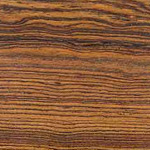Serving Upstate NY—VT—MA • For selections & prices, CALL or EMAIL US
Bocote
Wood Flooring Species
Scientific Name:
Cordia gerascanthus
Other Names and Species:
Canaletta
Cordia
Cype
Freijo
Louro
Princewood
Solera
Salmwood
Ziricote
Origin:
Tropical America and West Indies (Mexico, Guatemala, Honduras, Nicaragua, Colombia, Cuba, Dominican Republic, Haiti, Jamaica)
Appearance:
Prized for its beauty, bocote is a particularly fine, beautiful wood, ranging in color in the heartwood from light to golden brown, with irregular blackish streaks. The sapwood can be grayish or yellowish. If quarter-sawn, the wood has an attractive ray-fleck figure. The grain of bocote is usually straight or shallowly interlocked. The texture is fairly uniform and typically ranges from fine to medium, with a somewhat waxy or oily appearance.
Properties:
A very dense wood, bocote is moderately strong and durable. The bending strength of bocote is comparable to that of teak, while the compression strength is comparable to that of mahogany. It is highly resistant to insects.
Janka Hardness: 2200
Bocote is one of the hardest and most durable choices for wood flooring. It is one hundred and twenty percent harder than teak, sixty-one percent harder than white oak, fifty-one percent harder than hard maple, about twenty-one percent harder than hickory or pecan, fourteen percent harder than jarrah, identical in hardness to santos mahogany, and is almost ninety-four percent as hard as Brazilian cherry’s ranking of 2350.
Workability:
Bocote is easy to work, and it responds well to both hand and machine tools. It takes nails and screws well, and it is easily glued. It also polishes to a smooth, clean finish.
Principal Uses:
Sought for both its beauty and workability, bocote is in great demand for wood flooring, interior trim, furniture, boat decking, veneers, decorative inlays, and fine cabinetry.





